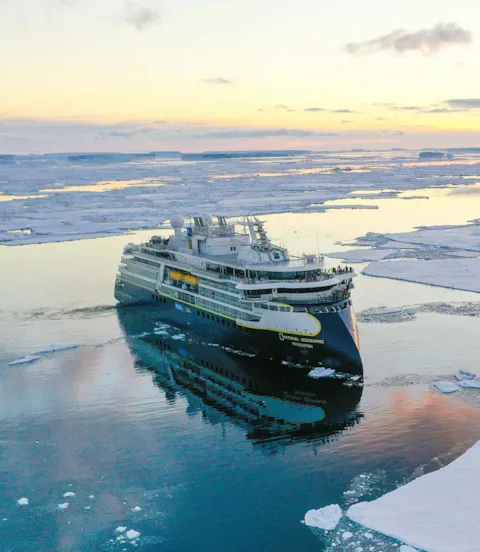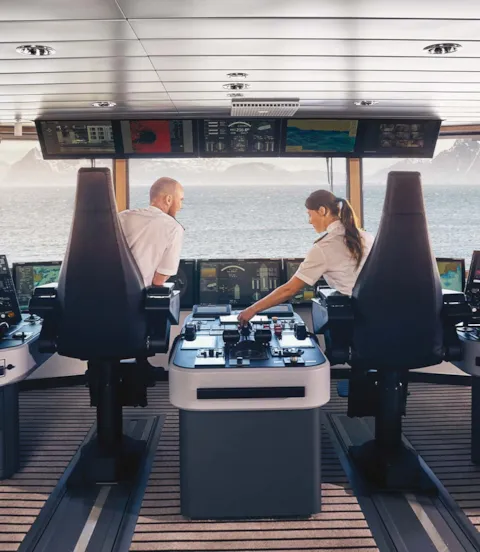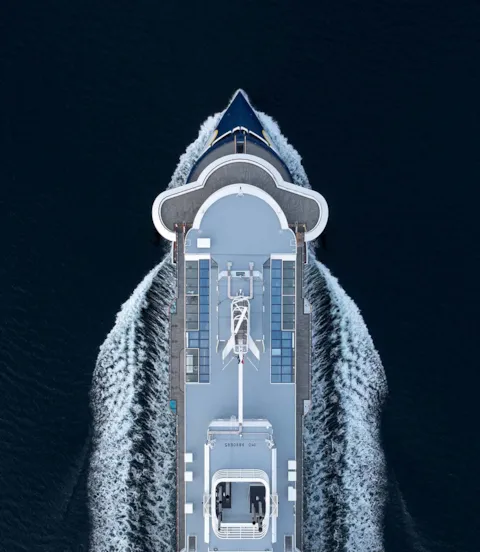Best practices for safe operations in challenging environments
Minimizing risks and environmental footprints during extended trips to Earth’s most remote and pristine areas are key operating tenets for the pioneer of expedition cruises, Lindblad Expeditions. A safety culture that goes beyond standards plays a central role.

Balancing adventure and safety
Providing unique opportunities to visit Earth’s most remote sea regions and experience some of the last pristine, wild environments is the unique selling proposition of Lindblad Expeditions. Established in 1979, the company specializes in adventure travel on small vessels co-branded with National Geographic. “We were the first to venture into the Antarctic area and the Galapagos Islands more than 50 years ago, and safety started there,” says Skarda. “At the same time, the areas we visit are very sensitive and need to be protected.” One of the company’s core principles is to “balance adventure and safety”, which means using every available means to keep guests safe while still providing them with an immersive experience of nature’s wonders.

Four safety principles
Lindblad takes a four-pronged approach to safety, says Skarda: “Custom-designed tools, such as Zodiacs, kayaks and other equipment, are key to our safety concept. Our new vessels, National Geographic Endurance and National Geographic Resolution, were the first Polar Class 5 passenger ships; they are DNV-classed, and designed to ensure safety, redundancy and a high-quality guest experience, based on past experience.” Preparing a new itinerary or destination sometimes takes years, he adds. “The second component to our safety approach is to acquire and develop the best expertise we can find. Our ice captains are among the most experienced in the world, and we train most of our key staff ourselves to build and maintain the expertise and core knowledge we need.”
Our new vessels, National Geographic Endurance and National Geographic Resolution, were the first Polar Class 5 passenger ships; they are DNV-classed, and designed to ensure safety, redundancy, and a high-quality guest experience, based on past experience.
The third safety principle is a very robust approach to risk monitoring while benefiting from lessons learned. “We call it Dynamic Risk Assessment,” says Skarda. “Part of it is our Voyage Risk Assessment Tool, or V-RAT, developed decades ago.” The company has also created an extension to the Polaris polar code system, an evaluation tool for ice conditions, to make it more robust and include additional types of ice. In addition, Lindblad modified its risk assessment tool for use in the South Pacific islands to help evaluate dynamic sea conditions and determine whether it is safe to perform a planned operation.

Risk monitoring and contingency planning
“Our risk monitoring system incorporates both internal and external experiences,” explains Skarda. “Apart from mandatory incident reporting, we encourage our crews to report any close encounters. We evaluate the root causes and define lasting corrective action. Our compliance team performs follow-up audits and surveillances after each report. We therefore have a very good safety record.” Any major incident in the industry will prompt Lindblad’s experts to develop suitable tools to mitigate or avoid reoccurrence.
“Plan and Practice for Contingencies” is the fourth safety tenet. “We take this very seriously,” stresses Skarda. “A recent 30-day expedition through the Antarctic took us two years to plan. There were very few resources available on the itinerary, and we were outside the reach of rescue helicopters or planes. We considered every conceivable contingency, performed role plays and walk-through scenarios, and made sure we had a 30 per cent contingency on board.”

Equipped for worst-case scenarios
When the National Geographic Endurance received an emergency call during that voyage, the crew was well-prepared to help. A person on a Ukrainian fishing vessel had been hurt in an accident. The Lindblad ship travelled 800 miles to rendezvous with the fishing vessel and took the wounded fisherman on board, where he was immediately operated on by the physician in the fully equipped on-board hospital. “The patient was close to gangrene and could have died,” reports Skarda. “We took him to New Zealand and left him in the care of a hospital. The guests on board made a spontaneous collection to help him through his troubles and get home safely. All this was only possible because of our thorough contingency planning, which is part of our training and safety planning approach.”

Navigating decarbonization
Facing an increasingly watchful general public, Lindblad knows that its reputation depends on the credibility of its commitment to environmental protection. “One of our core principles is to minimize our impact on the areas we explore,” says Skarda. “We started decades ago using the best and most efficient technologies available. All our ships run on clean-burning MGO, and our two youngest vessels have the only EPA Tier 4 diesel engines in the expedition industry.”
In 2018 Lindblad decided to become carbon-neutral by purchasing carbon offsets for all emissions across the company. But for individual ships to become carbon-neutral, there have to be further technology developments, Skarda points out.

Operational safety limits fuel choices
Being able to carry enough fuel and having the most reliable propulsion technology are matters of survival when sailing the most remote areas on Earth for weeks without access to bunkering. “These constraints limit our alternative fuel options,” explains Skarda. “We are testing various technologies for potential future newbuilding projects. But current studies indicate that significant amounts of alternative fuels will not be accessible until at least 2035.”
Although Lindblad’s polar vessels are – with one exception – exempt from many emission regulations because of their small size, Lindblad is looking for ways to further minimize carbon emissions. Direct emission measurements inside the exhaust gas stream could let the team on the bridge see in real time how their operational decisions influence carbon intensity, and take appropriate action. Class plays a key role in assessing technologies before they can be applied in expedition vessels with confidence, says Skarda.

Digitalization creates transparency
Digitalization can take the complexity out of advanced technologies, helping users understand how on-board systems operate, interact and affect safety, operation and emissions. “We need digital technology to enhance transparency and support decision-making on board,” says Skarda. “The engines and Azipods on board National Geographic Endurance and National Geographic Resolution are monitored remotely by the manufacturers, and we are planning to implement additional remote monitoring equipment.”
Navigating in remote areas safely where sounding data are scarce can be a challenge. Therefore Lindblad subscribes to OLEX, a crowdsourced, cloud-based worldwide sounding database. It is a valuable resource, and the Lindblad crews frequently use it and contribute their own seafloor scanning data. “As a valuable situational awareness tool, it keeps people safe by preventing grounding,” says Skarda.
Lindblad University, a digital training platform, is the company’s answer to training challenges as on-board systems get more and more complex and crews are expected to understand and manage them with confidence. The platform will be taken to the cloud soon, says Skarda, so it can be accessed from anywhere and help crew members keep their qualifications current.

Partnering with DNV
Having DNV by its side in all this is reassuring to Lindblad, considering the enormous breadth of digital opportunities and challenges, including cybersecurity or crew training. Especially in polar areas where one issue could have far-reaching consequences, being protected against cyber risks is essential. And as a company dedicated to safety, technical excellence, environmental protection and compliance, it is in Lindblad’s DNA to go above and beyond regulations, says Skarda.
“We really appreciate the support DNV gives us, not only in newbuilding projects but also as our external auditor who looks at all our systems. Having worked with DNV as our strong partner for many years, we specifically chose DNV again for our new polar vessels. DNV has solid expertise in ice navigation, and we knew DNV was going to hold the shipyard to account to make sure that the new vessels would operate safely in remote areas. I think the National Geographic Endurance and National Geographic Resolution are the best-built polar-class expedition vessels in existence, and I believe that this is to a large extent owing to DNV’s efforts to hold the shipyard to their and our high standards.”

- Lindblad Expeditions - Sarah Culler
- Ulstein Group ASA
- Lindblad Expeditions - Oivind Haug
- Ulstein Group/uavic.com
- Lindblad Expeditions – Oclin
